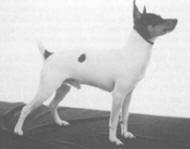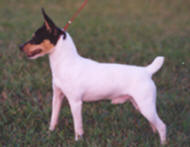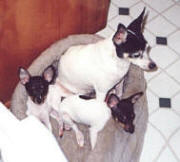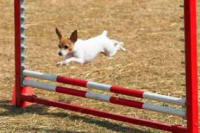American Kennel Club
AKC Breed Standard - Toy Group
Approved: July 8, 2003
History
To create this breed, some American fanciers crossed small Smooth Fox
Terriers with various toy breeds including Min Pins, Italian Greyhounds,
Chihuahuas and Manchester Terriers. The resulting dog - the Toy Fox
Terrier - retained the gameness from the terriers and a milder, more
"livable" disposition from the other breeds used. This truly American
creation is a big dog in a small package, possessing intelligence,
courage and a take-charge attitude. Today, the Toy Fox Terrier is a
well-balanced toy dog of athletic appearance displaying grace and
agility in equal measure with strength and stamina. From the hunt to the
show ring, the Toy Fox Terrier has become a cherished companion dog and
excellent show piece. The Toy Fox Terrier has shown that he is at home
in conformation, obedience and agility trials, his favorite spotlight is
the center stage of his owner's life.
The Toy Fox Terrier is a toy and a terrier, and both have influenced his
personality and character. While retaining the terrier gameness, courage
and animation. The cross-breeding with various toy breeds still a
working terrier, and many of them delight in hunting and going to
ground. Given the opportunity, the Toy Fox Terrier will pursue the
quarry of the backyard or barnyard with diligence. Known to tree
squirrels and flush out rodents, the hunt is always welcome. Flyball or
fetch are easily learned and perfected for endless hours of activity.
However, if you enjoy a lap dog, this little companion appears to know
the latest in television entertainment of his household. Children
especially enjoy the unending energy and zeal for play throughout this
dog's life.
General Appearance
The Toy Fox Terrier is truly a toy and a terrier and both have
influenced his personality and character. As a terrier, the Toy Fox
Terrier possesses keen intelligence, courage, and animation. As a toy
his is diminutive, and devoted with an endless abiding love for his
master. The Toy Fox Terrier is a well-balanced Toy dog of athletic
appearance displaying grace and agility in equal measure with strength
and stamina. His lithe muscular body has a smooth elegant outline which
conveys the impression of effortless movement and endless endurance. He
is naturally well groomed, proud, animated, and alert. Characteristic
traits are his elegant head, his short glossy and predominantly white
coat, coupled with a predominantly solid head, and his short high-set
tail.
Size, Proportion and Substance
Size: 8.5 - 11.5 inches, 9 -11 preferred, 8.5 - 11.5 acceptable.
Proportion: The Toy Fox Terrier is square in proportion, with height
being approximately equal to length; with height measured from withers
to ground and length measured from point of shoulder to buttocks.
Slightly longer in bitches is acceptable. Substance: Bone must be
strong, but not excessive and always in proportion to size. Overall
balance is important.
Disqualification: Any dog under 8.5 inches and over 11.5
inches.
Head
The head is elegant, balanced and expressive with no indication of
coarseness. Expression is intelligent, alert, eager and full of interest.
Eyes: clear, bright and dark, including eye-rims, with the
exception of chocolates whose eye-rims should be self-colored. The eyes
are full, round and somewhat prominent, yet never bulging, with a soft
intelligent expression. They are set well apart, not slanted, and fit
well together into the sockets.
Ears: The ears are erect, pointed, inverted V-shaped, set high
and close together, but never touching. The size is in proportion to the head and body.
Disqualification: Ears not erect on any dog over six months of age.
Skull: is moderate in width, slightly rounded and softly wedge
shaped. Medium stop, somewhat sloping. When viewed from the front, the
head widens gradually from the nose to the base of the ears. The
distance from the nose to the stop is equal to the distance from the
stop to the occiput. The cheeks are flat and muscular, with the area
below the eyes well filled in. Faults: Apple head.
Muzzle: Strong rather than fine, in proportion to the head as a
whole and parallel to the top of the skull.
Nose: Black only with the exception of self-colored in chocolate dogs.
Disqualification: Dudley nose.
Lips: are small and tight fitting.
Bite: a full complement of strong white teeth meeting in a
scissors bite is preferred. Loss of teeth should not be faulted as long as the bite can be determined as correct.
Disqualification: Undershot, wry mouth, overshot more than 1/8 inch.
Neck, Topline and Body
The neck is carried proudly erect, well set on, slightly arched,
gracefully curved, clean, muscular and free from throatiness. It is
proportioned to the head and body and widens gradually blending smoothly
into the shoulders. The length of the neck is approximately the same as
that of the head. The topline is level when standing and gaiting. The
body is balanced and tapers slightly from ribs to flank. The chest is
deep and muscular with well sprung ribs. Depth of chest extends to the
point of elbow. The back is straight, level, and muscular. Short and
strong in loin with moderate tuck-up to denote grace and elegance. The
croup is level with topline and well-rounded. The tail is set high, held
erect and in proportion to the size of the dog. Docked to the 3rd or 4th
joint.
Forequarters
Forequarters are well angulated. The shoulder is firmly set and has
adequate muscle, but is not overdeveloped. The shoulders are sloping and
well laid back, blending smoothly from neck to back. The forechest is
well developed. The elbows are close and perpendicular to the body. The
legs are parallel and straight to the pasterns which are strong and
straight while remaining flexible. Feet are small and oval, pointing
forward turning neither in nor out. Toes are strong, well-arched and
closely knit with deep pads.
Hindquarters
Hindquarters are well angulated, strong and muscular. The upper and
lower thighs are strong, well muscled and of good length. The stifles
are clearly defined and well angulated. Hock joints are well let down
and firm. The rear pasterns are straight. The legs are parallel from the
rear and turn neither in nor out. Dewclaws should be removed from
hindquarters if present.
Coat
The coat is shiny, satiny, fine in texture and smooth to the touch. It
is slightly longer in the ruff, uniformly covering the body.
Color
Tri-Color: Predominately black head with sharply defined tan markings on
cheeks, lips and eye dots. Body is over fifty-per-cent white, with or
without black body spots. White, Chocolate and Tan: Predominately
chocolate head with sharply defined tan markings on cheeks, lips and eye
dots. Body is over fifty-percent white, with or without chocolate body
spots. White and Tan: Predominately tan head. Body is over fifty-percent
white with or without tan body spots. White and Black: Predominately
black head. Body is over fifty percent white with or without black body
spots. Color should be rich and clear. Blazes are acceptable, but may
not touch the eyes or ears. Clear white is preferred, but a small amount
of ticking is not to be penalized. Body spots on black headed tri-colors
must be black; body spots on chocolate headed tri-colors must be
chocolate; both with or without a slight fringe of tan alongside any
body spots near the chest and under the tail as seen in normal bi-color
patterning.
Faults: Color, other than ticking, that extends below the elbow
or the hock.
Disqualifications: A blaze extending into the eyes or
ears. Any color combination not stated above. Any dog whose head is more than fifty-percent white. Any dog whose body is not more than
fifty-percent white. Any dog whose head and body spots are of different colors.
Gait
Movement is smooth and flowing with good reach and strong drive. The
topline should remain straight and head and tail carriage erect while gaiting.
Fault: Hackney gait.
Temperament
The Toy Fox Terrier is intelligent, alert and friendly, and loyal to its
owners. He learns new tasks quickly, is eager to please, and adapts to
almost any situation. The Toy Fox Terrier, like other terriers, is
self-possessed, spirited, determined and not easily intimidated. He is a
highly animated toy dog that is comical, entertaining and playful all of
his life. Any individuals lacking good terrier attitude and personality
are to be faulted.
Disqualifications Any dog under 8.5 inches or over 11.5 inches. Ears not erect on any dog over six months of age. Dudley nose. Undershot, wry mouth, overshot more than 1/8 inch. A blaze extending into the eye or ears. Any color combination not stated above. Any dog whose head is more than fifty percent white. Any dog whose body is not more than fifty percent white. Any dog whose head and body spots are of different colors.
Approved: July 8, 2003 - Effective: August 27, 2003
Note: The original breed standard was Approved: July 11, 2000
and became Effective: April 1, 2001 after which time, there were significant changes as reflected above.
There is no reference to the changes on the AKC website or the Toy Fox
Terrier Club Of America site.
The first approved history and breed standard does however appear in its
original form on www.TheDogPlace.org, one of the first dog information websites and
the first to publish the UKC and AKC Toy Fox Terrier Breed Standards. Those wishing to do further research can click to go directly to the original AKC Toy Fox Terrier Standard
The Reference section contains stories, "Do Toy Fox Terriers.....",
Weight Pulling, Agility Breed Stars, and so much more.
Have fun. History may have been re-written but breeders today are making
history!

Very early UKC Toy
Fox Terrier National Grand Champion Gorden's Shamrock Lad, courtesy
Eliza Hopkins. Date unknown but quality is visibly top notch!
 UKC
and AKC Ch. Goldenhills Gone With The Wind, sired by by UKC National Grand
Ch. Apava Jet Setter, the #1 All Time sire. "Winston" was briefly owned by Toy Fox
Terriers O'BJ where he contributed his impeccable front, rear, and rock
solid topline, but not his body length.
UKC
and AKC Ch. Goldenhills Gone With The Wind, sired by by UKC National Grand
Ch. Apava Jet Setter, the #1 All Time sire. "Winston" was briefly owned by Toy Fox
Terriers O'BJ where he contributed his impeccable front, rear, and rock
solid topline, but not his body length.
 Margo
Carter's UKC Ch. "Precious" a Top Producer in UKC and for the Phoenix breeding program.
Margo
Carter's UKC Ch. "Precious" a Top Producer in UKC and for the Phoenix breeding program.
Precious lived well over 16 years, went everywhere with Margo and was indeed most precious!
Use the menu bar at top to get around the site. If you are looking
for a puppy, go to Puppies For Sale.
For accurate insight on how the breed developed, visit "Unabridged" Breed History
for interesting information on how the breed was developed - and how it wasn't.
I hope you have found the site interesting and informative. There is much more to explore in the Gene Bank which contains a lot of historical pre-AKC photos and
(gasp) gets into genetics just a little.
About The Breeder explains how important the Breeder's Pedigree
is and how having a knowledgeable mentor can make it all come together for new owners.
 Learn
why soundness and agility is still important in this feature story
Learn
why soundness and agility is still important in this feature story
Toy Fox Terrier Agility Champions
Go to www.TheDogPress.com for
unaligned news and breed features, dubbed The "National Enquirer" for the showing fancy.